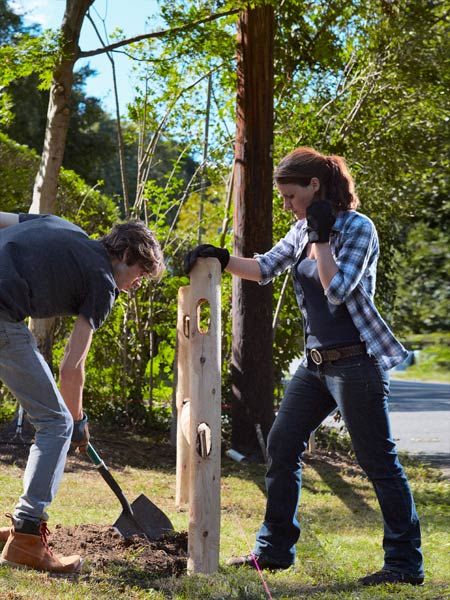

Like lodge pole or dimensional lumber fencing, it stands out as an attractive option to your property but doesn’t call a lot of attention to itself. And with the option of adding galvanized steel mesh, smaller animals can be contained as well without blocking your view. It’s perfect for containing larger animals and defining a property. This is the most rustic looking of the fences we offer and is very popular where privacy fencing isn’t needed or desired. Thanks for the article, it pretty much confirmed my thoughts on how this was done, but contained a few bonus pointers! Thanks again, God bless.There are a variety of products and styles available for open space ranch-style fencing.
#Diy split rail fence with branches full#
The parcel is heavily treed and I am planning on harvesting/making an old fashioned split rail fence around the full property (once I perform an inventory of the trees of course). I too love learning the old forgotten skills and this is why I stubled across your article. Thanks for the article, I'm moving onto a 5 acres parcel of land and am looking forward to establishing a small modest homestead. I want to do a couple more, but the trees are now all 80 feet tall and no place to fell them without hanging up, Enjoyed reading your article, BTW I am now 84 years old but still cutting and splitting my own firewood. But I have a nice fence in front of my house that will last literally forever, at least the rest of my life. Some came out pretty good but some are badly bent and curved. I have been making split rail fences for my own use, from black locust trees on my property. Next time, try to pick a line that will split the log in half without passing through a knot. When you re-direct your split to go around the knot, work slowly to help ensure that you won't split the wood where you don't want it split. If you encounter a knot on your way down the log, you will have to carefully split around it. The grain is all balled-up and twisted in there, so there's really nothing to split. Unfortunately, you can't split through knots-wood just doesn't work that way. I've run into a big knot, and the knot won't split! See the above instructions for straightening out your split. Focus on splitting the rest of the log properly, so that you can save the rails that are still in there. If it's not long enough to be a fence rail, just cut it up and use it for firewood. There's nothing you can do about the chunk of log that you've already split off. This can happen too, especially if you're not paying attention and you're dealing with twisted or knotty grain. I split off part of the log because my split ran off to one side, but it's not split in half! It is possible to keep pulling a twisted split back to where you want it. Stay focused on an imaginary straight line that goes right down the log from one end to the other, and keep sinking your wedges into that line. To correct this problem, you'll have to keep sinking wedges into the log where you want it to split, not where it's actually splitting. Speaking to the log isn't enough-you have to fight the twist in the log, which is a result of the way the tree grew. Twisted logs are hard to split into two equal halves, but you can do it. My split isn't straight, and my log isn't going to split into two equal halves! Basically, you'll be driving your wedge into part bark, part end-grain.

If this happens, try sinking the wedge into the edge of the end-grain, at a 45-degree angle to the ground. Sometimes the grain is really tight, and your wedge might pop out when you strike it. Sometimes you just can't sink your wedge directly into the end-grain of the log because you're working at a funny angle.

Here are some problems you might encounter, and my suggested solutions… My wedge won't go/stay in the end-grain! This article will, however, give you the information that you need to split a log and you'll be able to adapt that information as needed. If you actually decide to try your hand at splitting some fence rails, you'll find this article is a good guide but that it cannot possibly describe splitting every log that there is. What I intend to do with this article is to give you the basic idea, with instructions that are easy to follow. Please Note: Every log is different, so splitting logs for fence rails is a somewhat creative process that will be a little different every time. You will use your wedges to direct the split in the log all the way from one end to the other, "leap-frogging" your wedges as you go.

As you go, you will be able to remove your first wedge from the log as the split widens. You will then drive another wedge a little farther down the log. To do this, you will start at the fatter end of the log and drive a wedge into the end-grain. The idea is to use metal wedges to split the log first in half, then into quarters or smaller (if the log was big enough, to begin with).


 0 kommentar(er)
0 kommentar(er)
